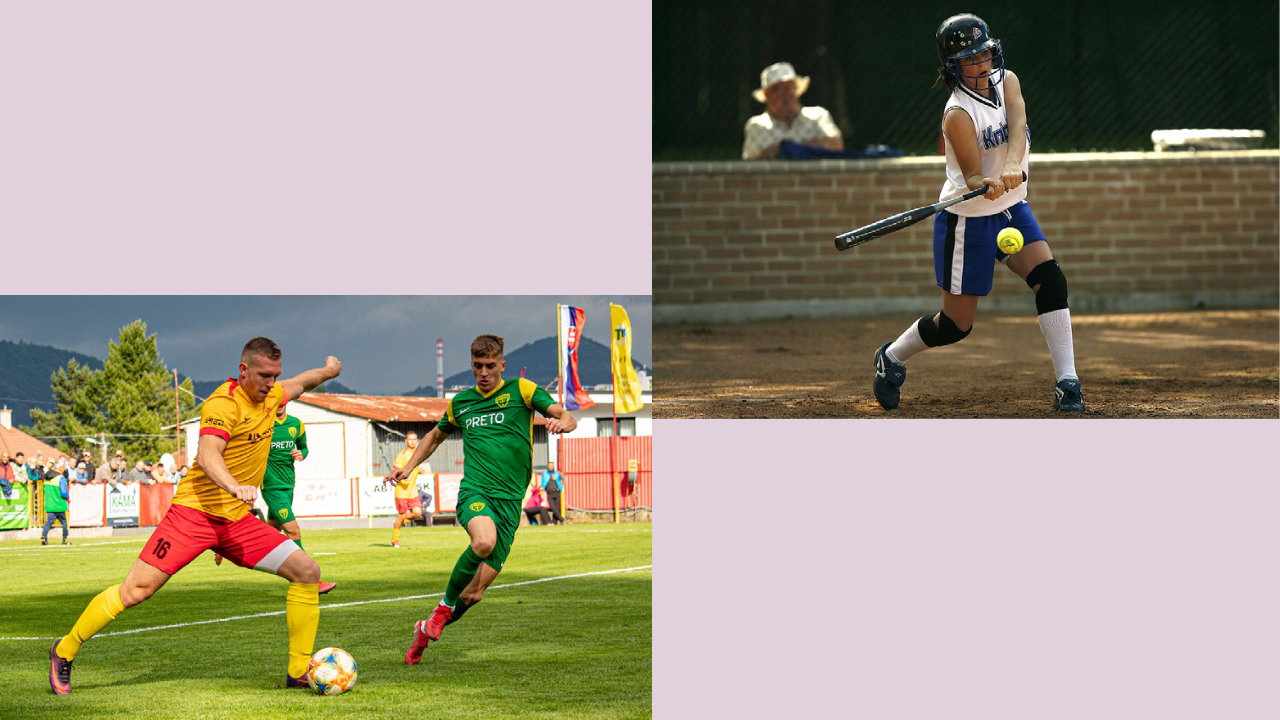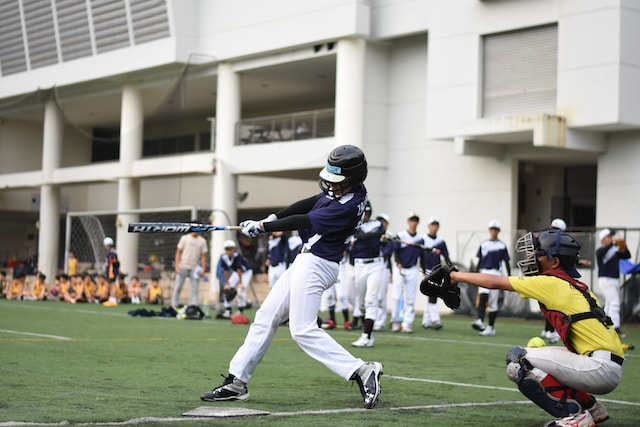
Are you looking for a pair of shoes to wear on the softball field? Do you have a couple of soccer cleats? Can you use them for softball?
It might seem like a good idea initially, but some essential differences between the two sports affect what type of shoe works best.
In this blog post, we’ll explore why soccer cleats aren’t always the best option for playing softball and provide tips to help ensure your feet stay comfortable during soccer games.
Can You Wear Soccer Cleats for Softball?
You can wear soccer cleats for softball, but it’s not recommended. Soccer cleats are made for playing on grass, while softball cleats are designed for playing on dirt or turf.
Soccer cleats have longer studs or blades to provide traction on grass, while softball cleats have wider-spaced and shorter studs for stability on dirt or turf.
Wearing soccer cleats on a ground or turf field may cause you to slip, trip, or injure yourself. Furthermore, some leagues may not allow metal cleats in softball, which are common in soccer cleats.
Wearing cleats explicitly designed for softball to ensure safety, performance, and compliance with the rules is best.
Read on to discover how to choose the proper footwear for your favorite sport!
Understanding the Differences Between Soccer Cleats and Softball Cleats

The differences between soccer and softball cleats may not be evident to the casual observer, but they can significantly impact your performance on the field.
Soccer cleats and softball cleats have some critical differences in design and materials; let’s explore the differences between them in detail.
Design:
The design of soccer and softball cleats differs significantly. Soccer cleats are designed to offer traction on different surfaces, such as synthetic or natural grass, and have a low profile to provide better ball control.
They also have a larger surface area covering most of the foot, including the top of the foot, to protect against tackles.
Softball cleats, on the other hand, are designed with enhanced ankle support to prevent ankle rolling while performing fielding actions.
They are long and wide towards the front to offer better stability and balance, and the spikes are more spread out than soccer cleats to improve traction on dirt or grass.
Material:
Soccer cleats are usually made of lightweight, durable materials such as synthetic leather, kangaroo leather, or mesh.
The materials provide maximum comfort and minimize break-in time, allowing soccer players to focus on their game instead of their footwear.
Softball cleats, on the other hand, are made of materials such as leather or synthetic materials that offer more protection and durability.
They provide additional cushioning and allow better ankle support, preventing injuries during the game.
Stud Pattern:

Soccer cleats typically have 12 or 13 short, flat-bottomed studs that offer excellent traction on the gaming surface, while softball cleats come with 8 or 9 spikes to provide a better grip on grass and dirt fields.
The spikes on softball cleats are also usually longer and narrower than soccer cleats, designed to penetrate the dirt and grass for added traction.
Softball cleats also feature a toe cleat that provides extra grip during acceleration and stops.
Position Specificity:
Soccer cleats are designed for specific positions, such as defenders, midfielders, or forwards, and come with unique features that cater to the player’s strengths.
For example, forwards need a lightweight and streamlined design to improve their speed, whereas defenders require cleats with more ankle support for strength and stability.
Softball cleats, however, are not position-specific and are designed to cater to the basic needs of all players, with a focus on stability, support, and durability.
Flexibility:
Soccer players need flexibility in their cleats to perform quick and agile movements, such as turning, dribbling, and shooting.
As such, soccer cleats are designed to be flexible to allow the maximum range of motion.
Softball cleats, on the other hand, have less flexibility and offer more support for lateral movements, which are common in sports.
Regulations:
Different sports have different rules for the types of cleats worn. Soccer cleats may be required to meet specific standards for stud length and shape.
while softball cleats may need to comply with rules about metal cleats or turf shoes, depending on the league and level of play.
Can you wear softball cleats for soccer?
No, softball cleats are not suitable for playing soccer. They are designed with different materials and spikes to provide stability and traction on dirt or turf fields rather than grass fields.
Furthermore, some leagues may not allow metal cleats in soccer, which are common in softball cleats.
Soccer players need flexible cleats with short and flat-bottomed studs to provide the agility they need in the game.
It’s best to wear soccer cleats designed explicitly for soccer when playing the sport.
What are the consequences of wearing soccer cleats for softball?
Wearing soccer cleats for softball can also lead to potential risks and consequences.
Soccer cleats are designed for a grass surface, which means the studs may be too long or too pointed for a dirt or turf field, causing potential tripping or injury.
Moreover, softball players often slide into bases or make sudden stops, and metal studs on soccer cleats could cause harm to other players during collisions.
It’s always best to wear the appropriate cleats for the sport you are playing to ensure safety, performance, and compliance with the rules.
Guide for choosing cleats for softball:
Importance of choosing the right type of cleats for the sport
When playing a sport such as softball, it’s essential to have the correct type of cleats for safety and performance.
The wrong kind of cleat can lead to severe injuries and can even put you at risk of being disqualified from the game.
Wearing soccer cleats for softball is not recommended because they are designed for different terrains and involve different types of movement.
Soccer cleats are built for running and provide less traction and support than softball cleats, putting you at risk during collisions.
Softball cleats are designed with specific features such as rubber studs or plastic nubs to ensure proper grip on the playing field.
Factors to consider when choosing cleats for softball

Field Type:
When choosing softball cleats, one of the essential factors you need to consider is the type of field you will be playing on.
A traditional grass field is the most common, and molded cleats are usually the best choice for this field type. Molded cleats have rubber studs or plastic nubs that provide excellent traction on grass fields.
Turf shoes are the way to go if you play on a turf field. Turf shoes are specifically designed for artificial surfaces and provide adequate grip, support, and cushioning the feet need.
Player Position:
Your position in the game also influences the type of softball cleats you choose.
For instance, pitchers, catchers, and other players who spend much time on their feet should consider metal cleats.
Metal cleats provide excellent traction and lateral support, which is vital for these players. Infield players, on the other hand, should consider molded cleats because they provide better agility and speed on the grass.
Depending on the outfield type and speed requirements, outfield players should consider molded or metal cleats.
Foot shape:
Another crucial factor to consider when choosing softball cleats is your foot shape.
Know your foot size and if you have any arch issues or other foot conditions that may affect the comfort and support you need from your cleats.
Some brands design cleats that cater to specific foot types, such as wide or narrow feet. Try out different brands and styles of cleats until you find the one that works best for you.
Personal Preferences:
Lastly, consider your personal preferences when choosing softball cleats. Do you want cleats that are flashy or more subtle in design? Do you prefer a specific brand or color?
Pick something that reflects your personality and style. Remember, you will wear these cleats for an extended period, so pick something you feel comfortable and confident in.
Recommended Types of Softball Cleats:
Now that we’ve discussed the factors you must consider when choosing softball cleats let’s talk about the three most popular types: molded, metal, and turf shoes.
- Molded cleats are versatile and offer excellent traction on grass. They are comfortable and have different stud lengths for other field conditions.
- Metal cleats are perfect for infield players and provide superior traction and support in any terrain.
- Turf shoes, as mentioned earlier, are designed for artificial surfaces and provide excellent grip, comfort, and durability.
Next Read: How to Stretch Out Soccer Cleats?
Conclusion
The type of cleats you choose is necessary not only for your performance but also for your safety.
It’s essential to take the time to consider all factors, such as field type, player position, foot shape, and personal preferences, before picking a pair of softball shoes.
The three most popular softball cleats are molded, metal, and turf shoes, each providing benefits depending on the playing conditions. Hopefully,
this article has helped you understand what to look for when choosing softball cleats.
Good luck with your search!
FAQs
Can I wear soccer cleats for softball?
Soccer cleats are designed for playing on grass or turf fields and may not provide adequate support and traction on other field types. Therefore, it is recommended to use softball cleats when playing softball.
Is it safe to wear soccer shoes for a softball game?
Soccer boots may not provide the same support and traction as softball cleats. Therefore, it is not recommended to use soccer boots for a softball game as it may result in an injury. It is best to wear specifically designed softball cleats when playing softball for maximum safety.
Can I wear the same cleats for both soccer and softball games?
While it is possible to wear the same cleats for both soccer and softball games, some key differences between the two sports should be considered. Soccer cleats tend to have more traction on grass fields, while softball cleats offer more support and protection on turf or dirt fields. Therefore, appropriate cleats for each sport are recommended to maximize your performance and safety.
What are the benefits of wearing soccer shoes for a softball game?
Soccer shoes offer excellent traction on grass fields which can be beneficial for playing some positions in softball. However, it is essential to remember that soccer shoes may not provide enough protection and support for playing on turf or dirt fields. Therefore, it is best to use specifically designed softball cleats when playing softball for maximum safety.
Can I use baseball cleats or baseball shoes to play soccer?
Using baseball cleats or shoes to play soccer is not recommended, as they are designed for different surfaces and movements. Baseball cleats have a heavier and more rigid construction than soccer cleats, and the studs or spikes may be longer or sharper, which can cause injury or damage to the turf or grass field.


